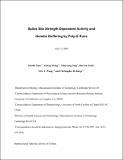| dc.contributor.author | Xiao, Xinshu | |
| dc.contributor.author | Wang, Zefeng | |
| dc.contributor.author | Jang, Minyoung | |
| dc.contributor.author | Nutiu, Razvan | |
| dc.contributor.author | Wang, Eric T | |
| dc.contributor.author | Burge, Christopher B | |
| dc.date.accessioned | 2011-10-25T13:49:55Z | |
| dc.date.available | 2011-10-25T13:49:55Z | |
| dc.date.issued | 2009-09 | |
| dc.date.submitted | 2009-07 | |
| dc.identifier.issn | 1545-9993 | |
| dc.identifier.issn | 1545-9985 | |
| dc.identifier.uri | http://hdl.handle.net/1721.1/66571 | |
| dc.description.abstract | Pre-mRNA splicing is regulated through the combinatorial activity of RNA motifs, including splice sites and splicing regulatory elements. Here we show that the activity of the G-run (polyguanine sequence) class of splicing enhancer elements is approx4-fold higher when adjacent to intermediate strength 5' splice sites (ss) than when adjacent to weak 5' ss, and approx1.3-fold higher relative to strong 5' ss. We observed this dependence on 5' ss strength in both splicing reporters and in global microarray and mRNA-Seq analyses of splicing changes following RNA interference against heterogeneous nuclear ribonucleoprotein (hnRNP) H, which cross-linked to G-runs adjacent to many regulated exons. An exon's responsiveness to changes in hnRNP H levels therefore depends in a complex way on G-run abundance and 5' ss strength. This pattern of activity enables G-runs and hnRNP H to buffer the effects of 5' ss mutations, augmenting both the frequency of 5' ss polymorphism and the evolution of new splicing patterns. Certain other splicing factors may function similarly. | en_US |
| dc.description.sponsorship | American Heart Association | en_US |
| dc.description.sponsorship | Human Frontier Science Program (Strasbourg, France) | en_US |
| dc.description.sponsorship | National Institutes of Health (U.S.) | en_US |
| dc.description.sponsorship | National Science Foundation (U.S.) (equipment grant DBI-0821391) | en_US |
| dc.language.iso | en_US | |
| dc.publisher | Nature Publishing Group | en_US |
| dc.relation.isversionof | http://dx.doi.org/10.1038/nsmb.1661 | en_US |
| dc.rights | Creative Commons Attribution-Noncommercial-Share Alike 3.0 | en_US |
| dc.rights.uri | http://creativecommons.org/licenses/by-nc-sa/3.0/ | en_US |
| dc.source | Burge | en_US |
| dc.title | Splice site strength–dependent activity and genetic buffering by poly-G runs | en_US |
| dc.type | Article | en_US |
| dc.identifier.citation | Xiao, Xinshu et al. “Splice site strength–dependent activity and genetic buffering by poly-G runs.” Nature Structural & Molecular Biology 16 (2009): 1094-1100. | en_US |
| dc.contributor.department | Whitaker College of Health Sciences and Technology | en_US |
| dc.contributor.department | Massachusetts Institute of Technology. Department of Biology | en_US |
| dc.contributor.approver | Burge, Christopher B. | |
| dc.contributor.mitauthor | Xiao, Xinshu | |
| dc.contributor.mitauthor | Wang, Zefeng | |
| dc.contributor.mitauthor | Jang, Minyoung | |
| dc.contributor.mitauthor | Nutiu, Razvan | |
| dc.contributor.mitauthor | Wang, Eric T. | |
| dc.contributor.mitauthor | Burge, Christopher B. | |
| dc.relation.journal | Nature Structural and Molecular Biology | en_US |
| dc.eprint.version | Author's final manuscript | en_US |
| dc.type.uri | http://purl.org/eprint/type/JournalArticle | en_US |
| eprint.status | http://purl.org/eprint/status/PeerReviewed | en_US |
| dspace.orderedauthors | Xiao, Xinshu; Wang, Zefeng; Jang, Minyoung; Nutiu, Razvan; Wang, Eric T; Burge, Christopher B | en |
| dc.identifier.orcid | https://orcid.org/0000-0002-6605-3637 | |
| mit.license | OPEN_ACCESS_POLICY | en_US |
| mit.metadata.status | Complete | |
